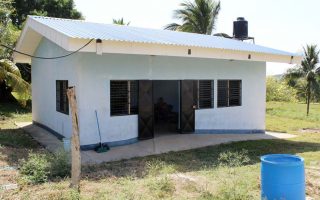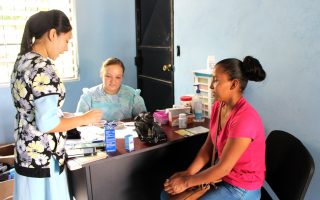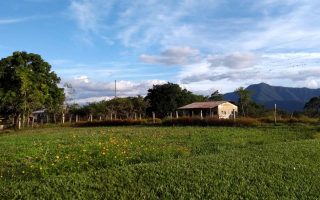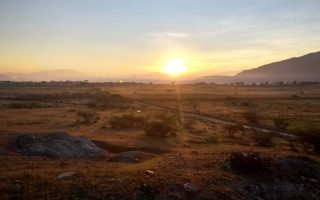- The community building offered us by the town administration for clinic use
- Marleny Molina and Lynelle Stutzman see a patient
Clinic Day in El Naranjo
El Naranjo is a busy frontier town along the San Pedro River, a “jumping off” point for the 1,300 square mile Laguna del Tigre National Park. Three miles beyond El Naranjo and the San Pedro River ferry lies the small village of Santa Rosita, home to about thirty families as well as the Rios de Agua Viva Mennonite Church. This is the town that my family and I now call home.
Among the mission efforts of the past years shines the work of the Buen Samaritano Clinic. After my family and I arrived, we quickly lost count of the comments that we heard about the good medicine and the caring service provided by our predecessors, and how the Mennonite clinic was different. Don’t we sell medicine? Don’t we see patients anymore? When will a nurse be able to come? We soon began to wonder, is this a door to people’s hearts that God has allowed to remain open, or is it just a conversation starter?
Over the past three years our interest in pursuing the clinic work in a small way has steadily grown. But with the mission’s personnel needs and lack of experienced staff, how would we begin? Could this work benefit and bless our local brotherhood as well as the MAM churches at large?
After much prayer and consideration, the board offered support to invite the team from the mission’s Buen Samaritano clinic in Oratorio, about thirteen hours away, to visit and hold clinics once a quarter. This pattern is not unusual here in Guatemala; many traveling teams of medical personnel visit rural areas to provide services where needs are often the greatest and options are often few.
On Saturday evening, January 23, a small medical team from Oratorio arrived in El Naranjo. We had been offered the use of a community building that formerly housed the government health clinic, and it provided ample space for the team to both live and work.
On Monday morning at eight o’clock, the doors of the Buen Samaritano Clinic opened in El Naranjo for the first time in years, with Priscila Muñoz serving as nurse, Marleny Molina serving as pharmacist, Sara Breneman taking labs and serving as nurse’s assistant, and Lynelle Stutzman serving as receptionist. For the next three days they labored to serve the varied cases that arrived, with at least twenty patients a day wanting a consultation with the nurse, and others coming to visit the pharmacy. A few even came just to see the display of Bibles and Christian literature for sale. There were enough patients to keep the staff busy, providing them with variation and practical experience in a new and very different setting.
After three days in El Naranjo, the crates of medicines and supplies were hauled back to the village of Santa Rosita. On Thursday, the team went to work in the small but nicely equipped public building in Santa Rosita, where a medical team from the nearby oil company occasionally holds clinics. It seemed that most of the village folks turned out at one point or another throughout the day. The team reports that the need for medicine and quality prescriptions is even more noticeable here in Santa Rosita than in El Naranjo. On their next trip to the area, they would like to start here to offer the best possible selection of medicine to the people who normally have the least access to it.
Only God knows what the future holds. For now, we would like to hold clinics for about one week out of every quarter. Our goal is to continue the clinic work here in Santa Rosita as a means of reaching out to our neighbors and to continue to work in El Naranjo, serving the townspeople and reaching out to the many people from isolated villages who arrive each day to do their purchasing in this larger town. Please pray for this work as we continue to investigate the options and seek God’s will for the future.
~ Dean Boll
- Rainy season: “For the earth which drinketh in the rain that cometh oft upon it, and bringeth forth herbs.”
- Dry season: “A dry and thirsty land, where no water is.”
As the Rain Cometh Down
Dust. We have it, and in great abundance! We are nearing the end of dry season—the time of year when the temperatures climb the highest, the earth cracks, the grass is withered, and the cattle are even skinnier than usual. The only green plants are a few irrigated cornfields, pine trees, and the cacti that line the roads and fences. We are eagerly anticipating the first rains of April and May. Aside from a few very brief sprinkles, we have not had any rain since November!
Perhaps I have been thinking more about rain because we recently drove through rain on a trip through Alta Verapaz. Our host in Coban told us, tongue in cheek, that they generally receive rain “thirteen months out of the year!”
Upon returning to our dry and dusty neighborhood just hours after viewing the lush, tropical Peten and the refreshingly cool and verdant Alta Verapaz area, the contrast was almost startling. We live in a dry and thirsty land. But in a few months, we, too, will have green grass and hear the relaxing sound of rain on our tin roof.
God promised Noah in Genesis 8:22 that While the earth remaineth, seedtime and harvest, and cold and heat, and summer and winter, and day and night shall not cease. The rains will come, even if not as consistently in some areas as they used to. God has promised that the natural cycles of nature will continue as long as the earth stands. Man can use his God-given ingenuity to make dams, wells, pumps, and pipelines to bring water to parched deserts, but even these things ultimately rely on water from the heavens.
What a difference rain makes! The guatemaltecos here frequently thank the Lord for the rain that waters their cornfields. This is good and proper, for it is God Who giveth rain upon the earth, and sendeth waters upon the fields (Job 5:10). Rain is mentioned at least ninety times in the Bible, mostly referring to the natural water cycle. Sometimes the word is used as a verb, as in Psalm 11:6 Upon the wicked he shall rain snares, fire and brimstone (judgment) or Hosea 10:12 For it is time to seek the Lord, till he come and rain righteousness upon you (blessing).
God, through the Prophet Isaiah, also used rain as an illustration that gives me much hope and strength as a missionary and pastor. For as the rain cometh down, and the snow from heaven, and returneth not thither, but watereth the earth, and maketh it bring forth and bud, that it may give seed to the sower, and bread to the eater: so shall my word be that goeth forth out of my mouth: it shall not return unto me void, but it shall accomplish that which I please, and it shall prosper in the thing whereto I sent it (Isaiah 55:10, 11).
Verse 11 sure looks like a promise! As we preach and teach, it often seems as though the message we painstakingly prepared and translated “goes in one ear and out the other.” But God says that the preaching and proclamation of His Word will accomplish its purpose. God’s Word will not fail. Yes, many will hear and reject, but others will accept the truth. Just as “sure as rain,” the Bible will prosper.
We have seen marvelous changes in individuals’ lives as God’s Word was taught and truth was grasped. When an illiterate farmer is transformed into a passionate disciple, it is not the missionary who deserves credit. When a notorious drunk is freed from his addiction and is heard singing praises to God in a clear and joyful voice, it wasn’t the pastor’s doing. When a sad and weary woman is flooded with a deep peace as she reads of God’s love, it wasn’t the bookseller who changed her life. The power of God’s Word and the Holy Spirit (which always agrees with God’s Word), are the agents of true transformation and healing. As Christians, our mission (as in missionary) is to bring the water of life (God’s Word) to a world full of thirsty people. Sadly, too many people do not understand what they are thirsty for. They busily seek satisfaction from the empty, broken cisterns of this world. Perhaps we need more people to live as “salt and light” among unsaved people to draw sinners to the Giver of rain and life. Perhaps we need to hunger and thirst after righteousness a little more ourselves. What would happen if we all sought after God as David did?
Psalms 63:1 says O God, thou art my God; early will I seek thee: my soul thirsteth for thee, my flesh longeth for thee in a dry and thirsty land, where no water is. We can only offer to others what we have first received. May God’s Word rain upon you, and God’s Spirit reign within!
~ Justin Zimmerman
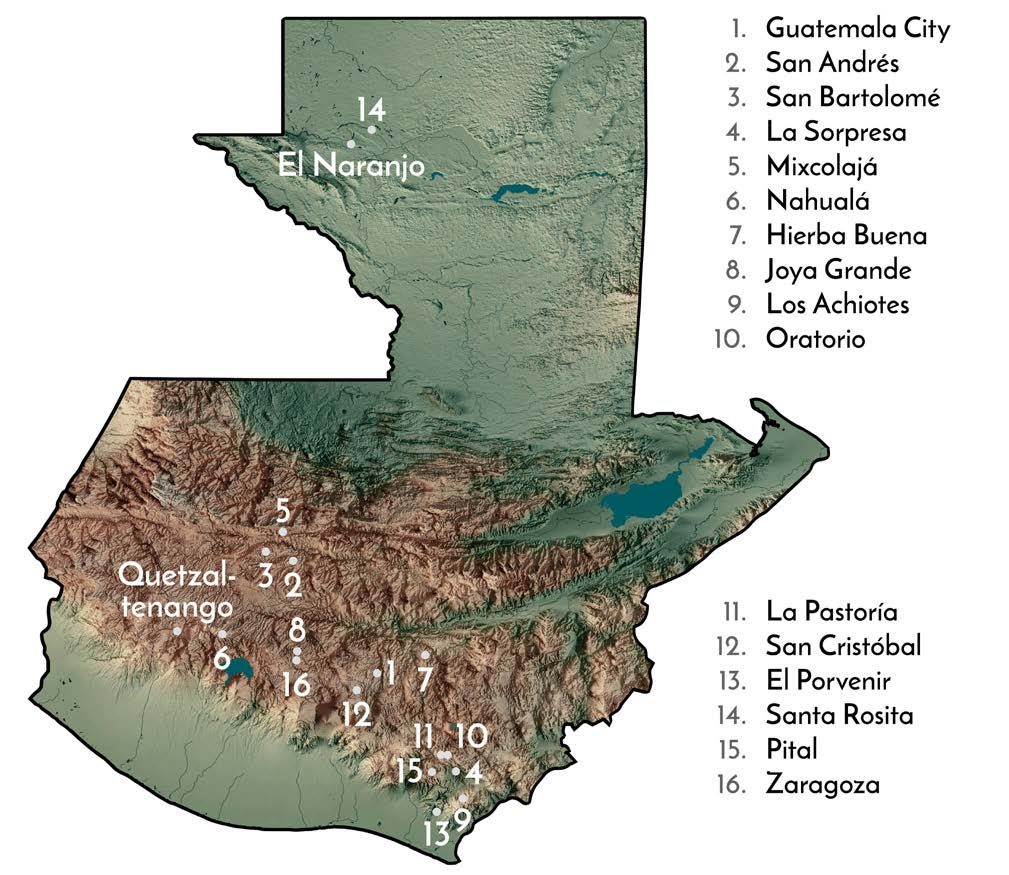
MAM’s Churches across Guatemala
MAM Churches and Leadership
In this newsletter we have often mentioned the need for more workers in Guatemala. While there are a variety of personnel needs, such as nurses for clinics, mechanics, and administrative positions; the most critical need has always been for church leaders. Our desire is for the Guatemalan brethren to ultimately lead their own churches, but there are very few who are qualified and willing. We trust that as these congregations mature, more leaders will emerge, but this takes time, teaching, and prayer. To emphasize the current situation, the following is an outline of the various MAM churches with the current leaders, the ages of those leaders, and the size of each congregation.
- Guatemala City (Lirio de los Valles) (28 members)
- Jorge Ávila – Ordained Deacon (age 93)
- Daniel Ticas – Ordained Deacon (age 62)
- Byron De La Rosa – Ordained Minister (age 53)
- San Andrés (9 members)
- Ismael Quiñónez – Ordained Minister (age 70)
- San Bartolomé (34 members)
- José Benito – Ordained Bishop (age 68)
- Galen Miller – Lay Leader (age 35)
- La Sorpresa (El Guayabo) (12 members)
- Justin Flamenco – Lay Leader (age 23)
- Mixcolajá (22 members)
- Leadership: Belisario Natareno – Commissioned Deacon (age 47)
- Justin Zimmerman – Commissioned Minister (age 30)
- Nicholas Suarez – Commissioned Minister (age 28)
- Nahualá (10 members)
- Leadership: Diego Tziquin – Ordained Deacon (age 73)
- Humberto Mux – Minister without charge (age 49) (Lives in Mixcolajá and travels on weekends)
- Hierba Buena (13 members)
- Leadership: Donaldo Álvarez – Ordained Minister (age 40)
- Joya Grande (5 members)
- Leadership: Ezekiel Mux – Lay Leader (age 70)
- Los Achiotes (12 members)
- Leadership: no local leadership
- Oratorio (27 members)
- Leadership: Francisco Segura – Ordained Deacon (age 90)
- Isaías Muñoz – Ordained Bishop (age 57)
- La Pastoría (3 members)
- Leadership: Daniel Meyer – Lay Leader (age 25)
- San Cristóbal (21 members)
- Leadership: Victor Ovalle – Ordained Bishop (age 70)
- Lester Burkholder – Lay Leader (age 70)
- El Porvenir (21 members)
- no local leadership
- Santa Rosita (15 members)
- Leadership: George Zimmerman – Lay Leader (age 41)
- Dean Boll – Lay Pastor (age 33)
- Pital (4 members)
- Larry Martin – Commissioned Minister (age 37)
- Zaragoza (23 members)
- Jerlin López – Lay Leader (age 38)
Note: “Ordained” denotes a leadership charge for life, whereas “Commissioned” denotes a leadership charge for a specific time (example: two years). “Lay Leader” denotes a brother who has been tasked with leading a congregation but hasn’t been given a formal charge.
Statistics and observations There are a total of sixteen MAM churches and ten ordained leaders, including three bishops. Of these ten, five are at least seventy years old. (Many of our supporting churches expect, or even require, that their ordained men “slow down” at age seventy and pass on their responsibilities to younger men.)
Only seven MAM congregations have a “plural ministry.” Only three have strictly Guatemalan leadership. Seven congregations have only one person in leadership, four of which are Guatemalan leaders. Currently, there are two congregations with no leader in their midst.
Historically, the Mennonite church has upheld the “plural ministry” as their leadership model, for Scriptural and practical reasons. Experience in Guatemala has shown that having a plural ministry working as a team is definitely advantageous for the health and stability of a congregation. Ideally, a plural ministry team would be made of ordained leaders living among the congregants, as opposed to commissioned lay leaders and leaders who live elsewhere and visit on weekends. This would help provide the long-term stability so lacking in many of the Guatemalan churches.
The membership count is not necessarily indicative of the size of the potential leadership pool in a congregation. For example, the San Bartolomé church has thirty-four members, larger than any other MAM church, but only four or five brothers who are “active,” including the two leaders named above. (“Active brothers” are those able to assist in church services by having devotionals, leading songs, teaching Sunday school, etc.) In Mixcolajá, a congregation with twenty-two members, there are six active brothers, including the three commissioned men. In San Andrés, a very small congregation, there are only two active brothers, including the ordained minister.
The advantage of a small church group is that each brother has responsibilities nearly every service, whether preaching, moderating, sharing a devotional, or all of the above. This tends to help those individuals grow, as it requires study and effort to prepare. The disadvantage is that constant giving, without receiving from others, leads to burnout. Also, the responsibility to preach a well-prepared sermon every Sunday (as most ministers are required to do) is a huge challenge, especially with the other responsibilities that demand attention from the pastor.
What can we do about this situation? First, please pray for these men who serve the church. Pray for their families and for their congregations. We are blessed to still have a number of faithful Guatemalan brothers who have served the church for decades, including during the years of guerilla warfare. We are trusting God to raise up another generation of faithful leaders from among the Guatemalan churchs. Second, please prayerfully consider serving in Guatemala! Yes, it means working hard to learn Spanish, a different culture, perhaps giving up a great job or a comfortable church situation; but God is faithful, and seeing lost souls come to God is truly rewarding!
For more information about serving in Guatemala, you can contact
- Wesley King at (717) 247-5115, [email protected]
- Brian Yoder at (276) 266-5807 or [email protected].
~ Justin Zimmerman
MAM Staff Needs
We are thankful for the families and individuals presently serving in Guatemala. The scope of the need is large, but we believe that God can raise up willing people to serve in these areas. As you consider the needs outlined here, please pray that God would send laborers into His harvest.
Immediate needs. We need a mission director, someone to assist the national bishops, and a family or couple for church-planting and pastoral work in Porvenir. We also need three single men for Oratorio, Porvenir, and mission headquarters.
Needs for the next year. We could use five families or couples to serve in church-related work in Oratorio, Los Achiotes, San Bartolomé, San Andrés, Joya Grande, and Santa Rosita. We could use an additional three single men to serve in San Andrés, San Bartolomé, and mission headquarters.
Needed by late 2022. We will need houseparents at mission headquarters and a business administrator.

